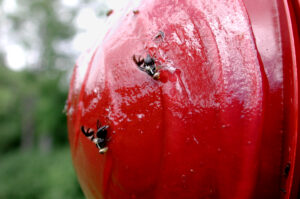2016 Post Harvest Fruit Injury Assessments: Insect Damage to Apple

The 2016 growing season had been devastating for many Hudson Valley growers. Beginning with April 5th-6th temperature drop resulting in the complete loss of peach, cherry, apricot and nectarine crops, growers also suffered significant losses in bud viability of apple with significant crop losses of 40% to 60% of the crop in the worst hit sites.
Scattered Rainfall & Apple Maggot: The potential for AM injury this season was directly correlated to quantity of infested fruit the previous year, with emergence potential increasing under relatively moist soil conditions from difference of rain events throughout the eastern part of the state, and varietial preference based on emergence timing. Damage levels were also related to residual capacity of the material / insecticide to repel AM or the efficacy of the insecticide to cause mortality to the adult, egg or larva during feeding, oviposition or emergence. The AM used to be called ‘Trailworm’ in the good ole days, apple varietial differences expressing AM larva movement and surface ‘trailing’ in red delicius and some green varieties more then others.
Adding to the season was low rainfall ending in severe drought and hail in other parts of the region. Drought conditions played a role in feeding injury from the stink bug complex on red and yellow colored varieties, likely caused by the native complex during the mid-season followed by pockets of Brown Marmorated Stink Bug (BMSB) feeding on late season fruit.
Forensically, its not possible to discern the stink bug species causing fruit injury during the season. However, presence through observations, even in low numbers of the pest, will often lend credibility to pointing to that species as the cause of the injury. We recorded native green and brown stink bug feeding on pear and apple beginning late July, and BMSB was not found in traps until mid-late August, with feeding on late varieties observed on a few farms. As injury does not express itself immediately on the fruit, often requiring 10 days to express dimpling and skin discoloration, apple with recent feeding by the SB complex shortly before harvested will be stored without blemish, only to find the same fruit with levels of fruit damage after its removal from cold storage. Efforts should be made to manage this insect complex prior to harvest.
Trapping efforts throughout the Hudson Valley have documented the presence of brown marmorated stink bug since late April, yet in very low numbers. However, its presence in border trees or even in traps has not, up until late August, been a sign of BMSB presence in orchards causing feeding damage. This lack of trap captures points strongly to the native SB complex as the cause of SB injury to fruit this season. BMSB movement into relatively few orchard ‘hot spots’ to intensively feed, are stocking up on reserves needed to successfully overwinter. This season we have not seen high numbers moving to overwintering sites. The use of border spray strategies to control BMSB activity appears to have been very successful from grower reports. Additional reporting on the 2016 season can be found in our 2016 Preliminary Report.
Much confusion about injury can arise at harvest given the four types of late season injury that can occur to fruit. These are:
* Stink bug injury of three different species (Green, Brown and Brown Marmarated stink bugs)
A discolored depression.
Always a ‘sting’ site in the center of the depression.
Upon slicing, corking up to the skin surface.
* Hail injury during the season
A discolored depression.
Never a ‘sting’ site in the center of the depression.
Upon slicing, corking up to the skin surface.
* Bitter pit from calcium deficiency requiring applications throughout the season
A discolored depression.
Never a ‘sting’ site in the center of the depression.
Upon slicing, corking separated from the skin surface.
* Apple maggot from oviposition or egg laying site or ‘sting’ in fruit surface
Sometimes a depression. Most often only slight discoloration.
Always a ‘sting’ site in the center of the depression.
Upon slicing, no corking BUT soft, oxidized fruit flesh, often with tunneling well into the fruit.
Sting larger then SB feeding site, and always easy to see.
Cutting directly beneath the sting will give rise to juice seeping up from the egg laying sting.
See images related to injury below.
Trapping efforts throughout the Hudson Valley have documented the presence of brown marmorated stink bug since late April. However, its presence in border trees or even in traps has not, up until late August, been a sign of BMSB presence in orchards causing feeding damage. Ths BMSB has recently begun movement into orchards to intensively feed, stocking up on reserves needed to successfully overwinter. In orchards throughout the Hudson Valley we’ve captured what we would consider the ‘Provisional Threshold’ numbers of adult BMSB in pheromone trap captures over the course of the past two weeks. First threshold as of 11th of September and continued populations above the 10 adult per trap threshold, sprayed prior to trap reset with an effective insecticide.
Indications of stink bug presence can be observed in the presence of live SB in fruit clusters and harvested bins with examples of fruit injury of varieties remaining on the trees as is shown in the photos below. Control measures should be taken if this type of fruit injury is being observed. Very few insecticides are very effective against this insect complex with regards to residual efficacy. Those listed below are labeled for use against BMSB in NY and represent the best of university and USDA bioassay tested insecticides that will help to reduce the injury and increase mortality of the population. Consider using a non-ionic surfactant to increase penetration of the active ingredients. However, a tight schedule of no less than 7 days should be made if new fruit damage and stink bug adults continue.






